Tableau: Jeanie Lee, Winter Shadow 2016

I was incredibly excited when I learned of Reed’s Winter Shadows program. I would describe the program as a take on ‘take your child to work day’, where Reed students shadowed different jobs with the intention of getting a better idea of what it would be like to work at said job. It’s a great way of understanding what career path you’re interested in. A great Winter Shadow is one in which you learned something significant: whether it be that you want to pursue said career path or that you definitely do not want to pursue it. Tableau was an amazingly successful Winter Shadow, because I discovered a place where I definitely, absolutely, want to be. Culture is an important part of what people look for in a potential employer. Culture, however, is so much more than just whether a company is fun or if the people working there seem cool or whether or not there are free snacks in the kitchen. Culture is whether or not the employees enjoy working where they work, are personally fulfilled by it, and believe the work they are doing is important and valuable. This was true for everyone I met at Tableau. Furthermore, the employees were happy, but not complacent, satisfied, yet free.
Tableau exemplifies a lot of what I’m interested in. It’s the perfect combination of art and technology with a dash of positive feelings. It’s a nurturing work environment that encourages its employees to pursue what they are interested in, and recognizes the hard work they do. Tableau Desktop is intuitive, beautiful and very powerful. We spent the week watching tutorials on Tableau, shadowing product consulting calls, talking to employees from different departments, and creating data visualizations using Tableau. We took rows of data in excel and found what was interesting or hidden in the data. We learned to come up with the right questions when presented with data. The employees at Tableau seem happy. Not just happy, but fulfilled- not something you encounter regularly. Tableau almost seems too good to be real, but I’m ready to believe it.
Continue reading Tableau: Jeanie Lee, Winter Shadow 2016
Elementary School Psychology: Maggie MacLean, Winter Shadow 2016
I participated in a two-day shadow with Moira Tofanelli, a school psychologist at two different public schools in Portland. As an art major completing a thesis that draws heavily from the field of psychology, I was excited to see where a career in psychology could take me in Portland. I will be graduating in May and I am thinking about what kind of job I would like in the near future, and teaching seems to be an obvious next step for me. It was a great exercise for me to think about what kind of school I want to be a part of and see how the public schools in Portland vary.
It was interesting for me to compare the two schools I visited, as they were very different in terms of philosophy and educational goals. In the developmental psychology class I am taking this spring, we have been focusing on different models of human development and the kinds of guidance and parenting strategies that support each model. The first school I visited, the Creative Science School, uses a constructivist educational perspective. Jean Piaget, a psychologist influential in the 1970s, is the best-known proponent of this philosophy. Constructivism values learning through experience and independent problem solving. In general, Piaget viewed child development as a series of stages, and children as tiny scientists who learn about their world through experimentation and add new information to existing mental schemas. In the classroom, a constructivist approach often manifests as lots of group work, experiential projects, and integration of different classroom subjects.
To me, Creative Science seems big and colorful and full of movement and the evidence of children. There are art projects all over the hallway walls, glitter-covered handprints, and photographs of the students. I had forgotten what it is like to be in an elementary school. Everything is kid sized and chaotic in the way things are when tiny humans spend six hours a day in an enclosed space.
Continue reading Elementary School Psychology: Maggie MacLean, Winter Shadow 2016
Learning How To Learn: Northwest Woodworking Studio, Jacob Hayman, Winter Shadow 2016

Even though I wasn’t sure what to expect, I had been looking forward to my shadow at the Northwest Woodworking Studio all winter break. I did some research on the studio, and found some YouTube videos of Gary Rogowski, the Reedie English major turned expert woodworker who was to guide me and Emily (a fellow Reed student and new friend) for the week. I soon realized I wouldn’t learn much about woodworking on the internet.
Entering the studio didn’t change my feelings of total ignorance. Emily and I talked with Gary briefly about his nonlinear path to becoming a premier woodworker and teacher, and we quickly got started making dovetail joints. Gary gave a demonstration and explained the mechanics of the tools first, but he didn’t want us to learn by listening. We had saws and chisels in our hands within minutes of first entering the studio. We hit the ground running, and the week didn’t slow down.
After going to Gary’s house and grabbing some lumber, Emily and I were assigned to construct a door for the studio office. Gary gave us an idea of what he wanted, but he left us to figure it out for the most part. We measured, cut the particleboard, made mistakes, and measured more. We had to frequently ask for help and guidance, but we eventually got it installed. It wasn’t the most attractive door, but it was a fun project and (hopefully) Gary won’t have to replace it any time soon.
Continue reading Learning How To Learn: Northwest Woodworking Studio, Jacob Hayman, Winter Shadow 2016
Oregon State Bar: Cristobal Mancillas, Winter Shadow 2016

Really… law school? That’s almost always what I end up hearing after I tell people that I have decided to apply for law school. As a thesising senior the two questions I am almost always asked are: What is your thesis about and what are you doing after Reed? Usually I smile, talk about my thesis for a bit but then reveal that I want to pursue law. The reactions are usually pretty polarized. Some people are excited and talk about a relative who’s a lawyer, or they look me in the eyes with genuine concern and ask why. They ask me why like I am about to voluntarily inject myself with some terrible disease. Why law school? After spending some nights working on Logic problems at my thesis desk and silently freaking out about all the debt I am about to accrue I started to understand the concern. When I heard about the Externship in the Oregon Bar, I knew this would be great opportunity to learn and ask others the same question: why pursue law?
I spent a few days as an extern with the Oregon Bar. I was lucky to have a fantastic and generous host, Amber Hollister, a former Reedie and General Councilor at the Oregon Bar. My goal was to learn about the dynamics of the legal profession here in Oregon but also the resources and opportunities available to me in the upcoming years as I work on my application materials. That I did, and also was able to meet a variety of inspirational and fascinating individuals who shared personal experiences that made me far more comfortable with the decision to pursue law.
For the first day, I shadowed different members of the Oregon Bar, learned how the bar regulates the legal profession, and about the services it offers to its members. I was really impressed by the work happening in the Diversity and Inclusion Division. I was able to meet the director and talk about the struggles that many young lawyers coming from marginalized communities often face and learn about the resources available to increase diversity in the legal profession here in Oregon. I felt like I was able to very honest with the director about my concerns and he even shared his own experience as a participant in some of the programs he now coordinates. I left feeling more optimistic about the prospect of pursing law school as well as enlightened about the difficulties I would likely face.
Continue reading Oregon State Bar: Cristobal Mancillas, Winter Shadow 2016
Hail Gary, Free of Briefcase: Northwest Woodworking Studio, Emily Zetkulic, Winter Shadow 2016
On the first day, he had us build a door. I had no idea what I was doing.
I don't mean that I was unsure of how to build a door; I unquestionably did not possess that knowledge. I mean I really didn't know what I was doing—that I was building a door, that this door would be the entrance to Gary's office indefinitely, that I would not sever a fingertip in the process. (Don't worry, Gary Rogowski '72 had us sign waivers.) But at the end of the day, after several hours of foggy instruction following, Jacob and I did have a door in front of us (and lo, one that barely creaked, certainly opened, and practically closed), and twenty fingers between us.
Over the next few days Jacob and I would build more wooden things, culminating in the execution of a real live chair prototype. We designed and chiseled and sawed and swept. We went out to lunch with the Master Woodworking students at a Cuban restaurant in Northeast. We were privy to the same assignments the Master students received, if not the same skill set.
Continue reading Hail Gary, Free of Briefcase: Northwest Woodworking Studio, Emily Zetkulic, Winter Shadow 2016
Rita Rosenkranz Literary Agency: Caroline McCulloch

As the heels of my boots clopped against the Upper West Side’s sidewalk, I couldn’t help but feel a bit glamorous. My breath fogging in the crisp New York air, my gloved hands clutching a cross-body satchel, I felt the sort of working-woman swagger I’d attribute to Tina Fey’s Liz Lemon strolling near 30 Rockefeller Plaza. True, a Sex and the City comparison might afford me a bit more elegance, but for an equally geeky, slobbish, and sandwich-loving individual such as myself, Liz Lemon is the epitome of professional sophistication. Though I wasn’t writing for a comedy sketch show, I too had navigated the streets of New York City, passing momentous buildings and crowds, to go to work.
Rita Rosezkranz’s Literary Agency is situated in a brownstone apartment building. Rita, an elegant and well-spoken woman (perhaps a new model of professional sophistication), runs it out of her home office. Representing a variety of non-fiction titles, she advocates for her authors by pitching their projects to potential publishers. Additionally, she reviews proposals that will go to publishers, making suggestions to improve the project’s salability. However, her work doesn’t end once a publisher picks up one of these proposals. I primarily aided Rita in finding avenues to promote her various projects, as well as bolstering her writers’ presences and reputes. This sort of research required a clear marketing strategy and thus a firm grasp on the platforms that would most effectively reach the targeted consumer.
When I arrived, I sat in on a call with Rita and Roxanna, the author of a newly released children’s book. I discussed with Roxanna what kind of leads would be most useful in establishing her platform. From there, it came down to scouring the Internet for pertinent articles and journalists. I continued to compile leads for Roxanna throughout my stay with Rita, but also edited multiple proposals and reviewed query letters.
Continue reading Rita Rosenkranz Literary Agency: Caroline McCulloch
NASA Ames Research Center: Evan Peairs, Winter Shadow 2016
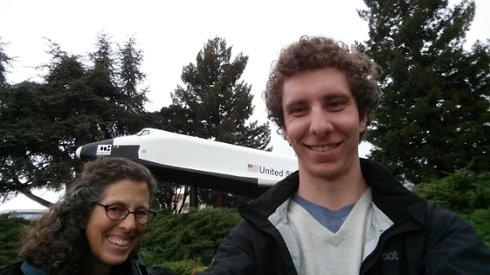
For two days last winter I had the wonderful opportunity to shadow Arwen Dave, a systems engineer at the NASA Ames research center. I was really excited to get to spend time at Ames - having grown up in the area, I'd often passed by their gigantic wind tunnel and wondered what awesome science was at work inside. NASA Ames is different from other NASA labs in that very little of their work is actual rocket science. A lot of their work involves designing, building, and operating the missions that the rockets actually deliver. Ames has a focus on robotics research, which is the field I'm currently trying to work my way into.
This opportunity came at a critical time in my search for career paths, as I had decided to put off grad school in order to try out future job paths before committing to one in particular. My main decision for which I was gathering information was whether continuing on in academia or shifting to an industry such as engineering would put me on a better career path. Ames was the perfect place to learn about future jobs, as there is a healthy mix of scientists and engineers working in close collaboration.
My time at NASA was split between following Arwen around on her job, taking tours of some of the labs, and wandering around talking to people about their jobs. I finally got to see the inside of a wind tunnel, and got to geek out with the local machinist over their awesome equipment. Following Arwen was very informative in that, for the first time, I got to see what it is that systems engineers do with their time. It turns out that the majority of the work consists of collaborating with lots of different kinds of people to try and get a project designed and built. Working at NASA in particular seems to make the job harder, since there's tons of added bureaucracy to deal with, but also a whole lot more rewarding, since you get to see your creations put into space. Arwen tends to be working on a number of different projects at once, and had a few tips for me on how to seek out and create new work opportunities within an existing position.
Continue reading NASA Ames Research Center: Evan Peairs, Winter Shadow 2016
Providence Brain and Spine Institute: Carly Goldblatt, Winter Shadow 2016
When I met Dr. Tracy Sax, it had been 3 years since I had given up my dream of becoming a doctor. I had taken an introductory Biology course and felt that I was not capable of doing the work it would take to achieve that goal. I expected this Winter Shadow to give me certainty that I was not interested in work as a clinician, particularly as an MD. As happens often in life, I got the exact opposite.
The dream was reawakened in a Pete's Coffee shop in North Portland. I sat down with Tracy Sax to do some introductions and preliminary instruction before the Shadow began. Her enthusiasm for what she did stood out to me in a way I don't see often. At first it scared me because I worried that my first bad experience with Biology leaving me with no passion for the field said something about me as a student. I thought if I couldn't make it through that there was no way I'd make it through medical school. But she was so encouraging, without even knowing me she encouraged me to go into medicine. Her enthusiasm was infectious.
We dealt with some really emotionally taxing material and I was proud of the way I handled that. I sat in on a session during which we preliminarily diagnosed a young man with ALS. I have felt confident in my potential as a clinical psychologist and this demonstrated that in this field, doctors get an opportunity to run tests and diagnose patients but also help them cope with these diagnoses, if only for a little while. Tracy handled the conversation in a personal and professional way. I learned that neurology is a field that could allow for a combination of my interests and skills in psychology.
Behavioral Neuroscience at the University of Washington: LB Miller, Winter Shadow 2016

One of the pictures I took of glowing antibodies in a brain slice
I can’t say that I ever imagined myself slicing up a brain before junior year of college. A few short weeks ago, I found myself doing just that: turning the huge crank on a deli-slicer-like machine to create a fifty-micron slice of rat brain. I then used an extra fine paintbrush to fish the brain slice out of the negative 22oC resting place and into a room temperature solution that would preserve it for future experiments.
I started high school thinking that psychology was the path for me. Somewhere between the first day of 9th grade and my first day at Reed, I reimagined myself as a rebel who would never follow in their parent’s footsteps. As a freshman I wandered around the philosophy department, and stuck my head in the political science department and finally, with much chagrin, signed up to take intro psychology my sophomore year.
Because I came home to psychology relatively late in my college career, I had to find my way through the department quickly. I had only three years to complete my major requirements, while those who knew what they were about from early freshman year had four. When I found myself enchanted with behavioral neuroscience, I found that I did not have room in my schedule to pursue this interest as well as graduate on time. This is when the winter shadow program appeared in my life and gave me a wonderful opportunity to explore the field of behavioral neuroscience in a hands-on way.
Continue reading Behavioral Neuroscience at the University of Washington: LB Miller, Winter Shadow 2016
St. Pauls Lutheran Church: Ava Kamb, Winter Shadow 2016
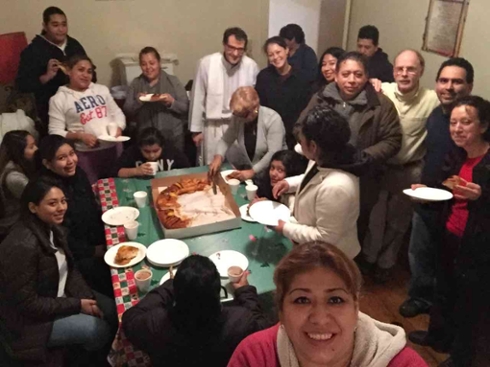
It would be impossible for me to define an average day during my externship in Brooklyn, New York this past January, as every day I engaged in activities as diverse as writing liturgy to learning how to handle a cordless drill. I shadowed Ben McKelahan, a Reed alumnus who works as a Lutheran pastor in Williamsburg, Brooklyn, serving both a Spanish-speaking immigrant population and Parables, a young adult artistic congregation. Part of his job involves bridging the two communities (who share the space of St. Paul’s Lutheran Church) in a neighborhood that is undergoing gentrification.
This externship gave me the opportunity to develop my understanding of religion in both an academic and a personal sense. At the start, I found church life foreign and abstract, as I did not grow up religious and my understanding of Lutheranism came from a movie and a couple of texts I read before flying to New York. But throughout the week I was able to learn quickly through lengthy conversations with Ben and through working with the various communities that make up the church in Brooklyn. While studying the bible with Lutheran pastors, shaking maracas at a Parables spiritual dance party, and sharing chocolate de maíz with immigrants from the Dominican Republic as they described their favorite psalms, I began to understand what it means to be part of the Lutheran church community, and each day I was struck by the warmth and energy of everyone with whom I interacted. I was curious to see how God becomes present in people’s day-to-day lives, and I think I saw it best in the relationships individuals shared with one another.
Although my future career plans are still hazy at this point, this shadow opportunity unequivocally made me a better student of religion. I have always loved traveling internationally because it gives me the opportunity to grow, explore, and challenge myself in new situations and cultures, and this trip reminded me that I can have these same experiences in my own backyard (so to speak) if I am willing to step outside of my comfort zone. I want to extend a huge thank-you to Ben for allowing me to shadow him and putting up with my endless questions, to Hannah for offering me a bed in her apartment, and to the other communities I spent time with, who welcomed me into their conversations, homes, and lives however briefly – I am very grateful.
Continue reading St. Pauls Lutheran Church: Ava Kamb, Winter Shadow 2016
Kartini Clinic for Pediatric Eating Disorders: Alicia Molina, Winter Shadow 2016
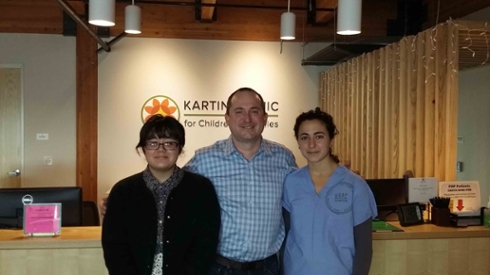
For the first two weeks of January, I had the opportunity to intern at the Kartini Clinic in Portland. I applied to this internship because it had somewhat to do with my major, and I had never been in a healthcare setting. I was curious how my skills applied to a pediatric eating disorder program and wanted to be a part of something that helps children and their families through this process. My sponsor was Morgan who is a Reed alumnus from 1994. I worked closely with him and Megan, who is head of the Business Office at the clinic. In this internship, I input data, analyzed it, and gave a presentation on my findings.
I was first of all very surprised with how much I was allowed to do. It was way more hands on than I was expecting which was a definite plus. As it was the beginning of the new year and December’s data had not been completely submitted, I started off with raw data entry. I thought my work would end there, but I was presented with possible questions about our patients that I could analyze. My first day there, I was able to participate in a finance meeting that went over revenue and expenses for 2015.
My primary job was to analyze patient data with regard to age, gender, and type of insurance for a nine-month period. Then, I came up with estimates on the average revenue of patient, average length of stay, and average revenue based on insurance. I worked closely with Megan in regards to the specifics of my analysis. We regularly checked in with one another both in person and though email. When she went to work off-site, we discussed the materials that I should look into the day prior so that I wouldn’t run out of things to do.
Metro Hazardous Waste: Nate Martin, Winter Shadow 2016

Metro is a large municipal agency based in the Portland area, though its influence is defined by a boundary that encompasses multiple cities in several counties. This January, I had the opportunity to spend two information-filled days meeting with and shadowing multiple Reedies who work at Metro.
The first day began at the regional center in Portland where I met my host, Jim. From there we got into a Metro-owned car and drove down to Swan Island to visit the MetroPaint facility. Metro runs a fantastic program there; there's nothing else like it in the country. Jim gave me a thorough tour of the facility, the most exciting part being the processing room. This is a sealed-off room where a small crew (four or five people in jumpsuits and rubber boots) receives and sorts containers of paint that have been collected from throughout the Metro region. The crew quickly opens the containers and inspects them for quality. If they're bad they get dumped into a drain leading to a large plastic tank. If they're good, they get mixed and dumped into one of about a dozen different stations, sorted by approximate color, that drain down to separate collection tanks. It's a messy assembly-line process, and fascinating to watch. The collected paint is further homogenized and adjusted to create standard colors that Metro sells commercially. All of this work, including the packaging, happens in the same facility. I had no idea of the extent or precision of this program before I visited Metro, and I was very impressed by the program’s ability to turn waste back into product.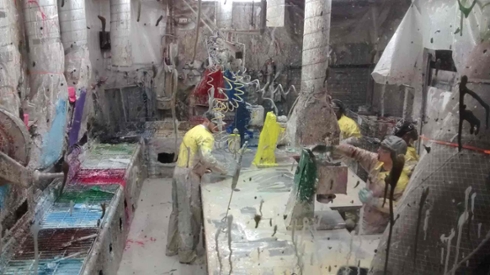
We left the MetroPaint facility after lunch and drove across the river to visit one of the two Household Hazardous Waste (HHW) collection centers that Metro operates (and that Jim manages). The operation there is efficient and impressive. Customers drive up with a load of waste that can include batteries, CFL bulbs, paint, pesticides, containers of mystery liquids, all kinds of things. A crew there does all the unloading while the driver stays in the vehicle. They quickly load everything onto small roll carts, triaging and sorting as they go. When the driver leaves they pay five bucks for dropping off up to thirty-five pounds of waste.
Continue reading Metro Hazardous Waste: Nate Martin, Winter Shadow 2016
California Emergency Physicians with Dr. Ruth L. Selvidge: Karla Velarde, Winter Shadow 2016
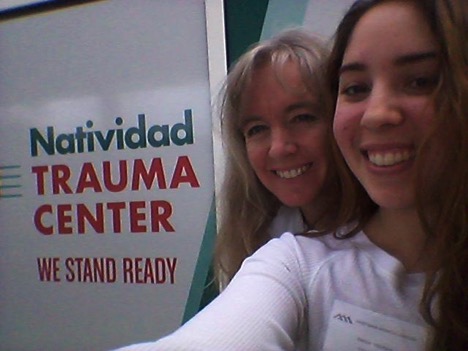
This January I shadowed Dr. Ruth Selvidge, an Emergency Department (ED) physician at Natividad Medical Center (NMC) for a week. NMC is a Level II trauma center and it is located in Salinas, California. The ED at NMC consists of a triage area at the front where patients are first reviewed by physician assistants and nurses. Based on this first examination, the patients are either discharged or they are sent to the back of the ED for further examination by the ED doctors. This is where Ruth steps in. Her job consists of examining these critically ill patients and determining the proper treatment. Ruth is usually accompanied by one or two ED doctors during her shifts, but there are some instances where she is running the ED by herself. She has 23 years of experience and was recently assigned as the temporary Assistant Director of the ED.
During this externship I shadowed Dr. Selvidge and discussed the cases with her. I learned about filing charts, illnesses and diseases, the scribe program at NMC, residency programs, and what a day looks like for an ED doctor. I learned a lot because Ruth always took the time to review the cases and explain their differential diagnoses. I observed interesting cases because, as Ruth put it, I brought a “black cloud” to the ED since every time I stepped in there were more trauma cases than usual: car accidents, gunshot wounds, stab wounds, among others.
Ruth informed me that the hardest part of her job is the humanitarian aspect. She explained that recently doctors are in front of a computer far more than with patients, due to the way information is archived.
Continue reading California Emergency Physicians with Dr. Ruth L. Selvidge: Karla Velarde, Winter Shadow 2016
Electric Power Research Institute: Kate Jentoft-Herr, Winter Shadow 2016
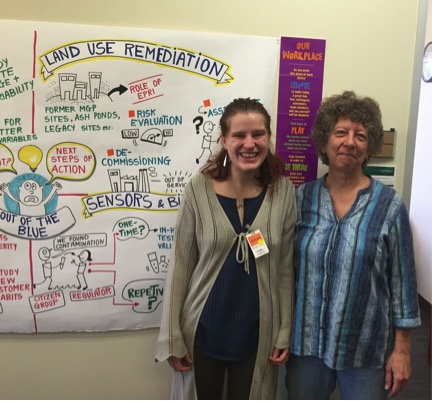
This January I spent a little less than a week shadowing Naomi Goodman at the Electric Power Research Institute in Palo Alto California. I was drawn to this shadow because I wanted a better sense of the kinds of career opportunities that exist for environmental chemists outside of academia. I was also interested in the fact that EPRI receives some of its funding for research from the power industry. I came into this shadow with the hope of understanding if this source of funding could potentially lead to a bias in the types of research that EPRI does.
After spending a week talking to Naomi and her colleagues I now have a much better appreciation for the work that EPRI does. EPRI does research for and receives funding from, a variety of different stakeholders, including their members in the power industry, but also the EPA and some environmental advocacy groups as well. EPRI’s goal is to gather and present data in the most objective, least biased way possible. They do not make policy recommendations or do advocacy work but strive to maintain a reputation of credibility and objectivity that makes them important allies to all third parties that require credible scientific analysis of environmental problems.
Naomi and the rest of the folks at EPRI were incredibly welcoming and hospitable. While I was there I got to have my own cubicle office and I spent most days working on my thesis, going with Naomi to meetings, and meeting with her collogues at EPRI and discussing their work. The people who I met with were, for the most part, project managers and no longer do their own research. They spend most of their time coordinating research projects, analyzing that research, and communicating the findings of that research to the agencies, companies, and other interested parties that are their members. This happens largely via phone calls.
Astronomy at the University of Michigan: Lizzy Arellano, Winter Shadow 2016
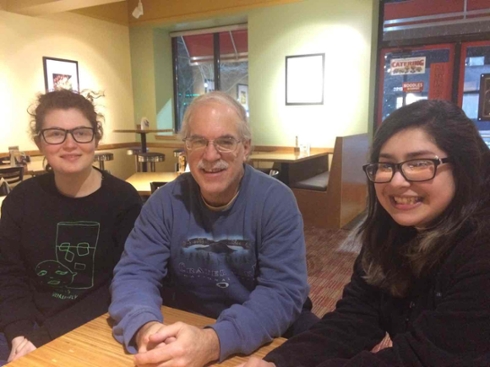
Going to dinner
The winter shadow that I had the pleasure of going to was far more fulfilling than I ever thought it could be. My hosts were very kind. Their homes were beautiful and their hospitality was very much appreciated. Ann Arbor, Michigan, was one of the most beautiful and easy to get around towns that I’ve ever visited. Mario Mateo’s house was about 2 miles from the University of Michigan, where Sarah and I worked most of the time. We found ourselves really looking forward to the walks every day. Not only was it really nice to pass through the urban and suburban areas of Ann Arbor, but it also gave us an opportunity to explore the downtown more. The food was delicious, the sights were see-worthy, and the snow was puffy. I feel so grateful to have received this externship because I will have otherwise never been able to visit Michigan.
As for the actual project, it was a great experience overall. Not only did I learn a lot of Python, a coding language, but also, I gained experience as an intern. I learned about the actual process of working with a data set and getting real results from my work that could actually contribute to scientific process. Because we were using data from the Magellan Clay Telescope in Chile, where each fiber attached to a plate referred to a specific star in the star cluster, Omega Centauri, we were working off Mateo’s idea of a new way of star cluster analysis. We had to be very careful with our calculations, checking and rechecking for the expected results. We had to generalize our coding, so that when new data comes in, it could be analyzed using the same programs and so that people all over the world would have the opportunity to do the same type of analysis. At the end of our externship, our work rewarded us with a complete spectrum of the stars we analyzed, which allowed Mateo to analyze the spectral lines for different elements contained in the stars.
Northwestern University Press: Manon Gilmore, Winter Shadow 2016
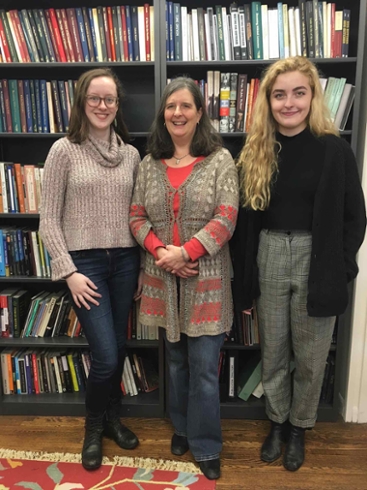
When I arrived in Chicago to spend a week this January shadowing Anne Gendler, managing editor in design and production at Northwestern University Press, I admit I didn’t know what to expect. I had always thought of the publishing industry as notoriously difficult to infiltrate, a cutthroat business where productivity and ambition were valued in a time where people are fond of saying that print is dying. Yes, this was a small press, but would it be different?
My first hint that I had nothing to worry about was when I matched the street number I had typed into my phone with a small house that had a “Northwestern University Press” sign out front. Inside was toasty warm (outside the temperature was single digits verging into the negatives, but Chicagoans are good at staying warm), and I was followed in by Grace, the other Reed extern who had arrived the week before. When we had tramped upstairs and shed all of our layers, our arrival was greeted with a cheer, and we immediately got to work.
Equipped with a red pencil and a loaner copy of The Chicago Manual of Style, I spent my week at the press checking passes of manuscripts—essentially different rounds of edits—against each other, proofreading e-books and one author-made index, and attending staff meetings, where all aspects of the process were discussed to see what progress had been made in the week between meetings: acquisitions editors introduced their new books, project editors updated the status of manuscripts undergoing editing, sales and marketing people talked about cover design and material, book size, selling points, and likely audiences.
Continue reading Northwestern University Press: Manon Gilmore, Winter Shadow 2016
Saturday Academy: Orion Cohen, Winter Shadow 2016
It is difficult to articulate exactly how I imagined non-profits before my time at Saturday Academy. My mental image resembled the bureaucratic equivalent of a panda, accepting donor funds, holding events, and slowly ambling towards its goal of benefiting the greater good. At Saturday Academy I quickly learned that whatever my conception was, it was utterly and completely incorrect. A non-profit is more like a spider in the center of a vast and intricate web of connections. It interfaces with donors, volunteers, and consumers to harness the latent desire of a community to improve itself and manifest that desire into a powerful force for good. Saturday Academy gives thousands of curious students the opportunity to indulge their interest in science with the help of talented community professionals. On a weekly basis, Saturday Academy accomplishes the incredible logistical feat of organizing hundreds of students and teachers into multiple locations across the city. When I asked Jeri Janowsky, Saturday Academy’s director and one of the most capable people I have ever met, how this was done, she jokingly told me, “complete chaos.” My time at Saturday Academy gave me enormous respect for both the mission and staff of the organization.
Additionally, I gained an understanding of the organization and operation of non-profits through a series of semi-independent projects assigned by the staff. Rather than merely observe the organization, I contributed to it, which was rewarding and educational. My observation of Saturday Academy’s structure taught me the most important lesson of all, the necessity of networking. I discovered that what I had negatively conceived of as schmoozing is in fact of a critical part of individual and organizational success.
It would be difficult to envision a more positive externship experience than the time I spent at Saturday Academy. I am incredibly grateful for the opportunity to work at Saturday Academy and honored that I was chosen as extern. I am also thankful for the hard work of The Center for Life Beyond Reed that facilitated the experience.
Continue reading Saturday Academy: Orion Cohen, Winter Shadow 2016
New York State Assembly: Mauricio Hernandez, Winter Shadow 2016

In the weeks before my winter externship began, the rare feelings of excitement that I could muster were always accompanied by anxiety. I had accepted an opportunity to shadow Elana Shneyer the chief of staff of Daniel J O’Donnell a prominent State Assembly member in Manhattan and in that moment I was thrilled. I had never been to the East Coast, let alone New York, and I would be working in a field that I had zero exposure to.
But once I purchased my plane tickets, the reality of my decision hit me. I was going alone to a city the size of which I had never been in and was expected to excel in work that I could not prepare for. And it had cost a pretty penny.
Needless to say I left for work over half an hour earlier than I needed to the first day, worried that I would become victim to the maze I envisioned the subway system to be. On the ride, I skimmed through advice articles with titles such as “How to make the best out of your internship,” and paid careful attention to the voice buzzing through the intercom.
Continue reading New York State Assembly: Mauricio Hernandez, Winter Shadow 2016
Graphic Design with Ecova Inc: Oscar Guerrero, Winter Shadow 2016
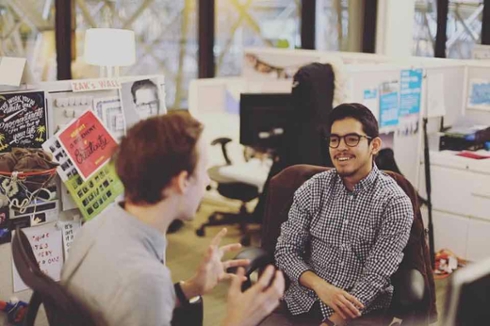
Graphic Design is something that is relatively very new to me. I officially started doing graphic design when I worked as a graphic design intern at the Center for Life Beyond Reed last summer, but I was untrained and it was very touch-and-go. I quickly discovered that I had a knack for it, and that design came naturally for me, and I worked myself really hard to be as proficient as possible. I watched YouTube videos, looked at other designers’ work, and did my own research to refine my skills. I realized I had a lot of potential, which excited me because I feel graphic design could open up a career path I had never really considered. Being a studio art major, I always had this fear in the back of my mind that I would graduate with a BA in fine arts and then would never be able to make a sustainable living just doing art. Graphic design, however, is a marketable career path that I feel extremely passionate about.
Skip forward to my Winter Shadow. I got to shadow Shawn Ingersoll and his fellow design team at Ecova Inc. Ecova is a not a household name, but it absolutely should be. The Ecova team is hired by other companies and utilities, to eliminate all forms of inefficiency in the practices of those other companies. Ecova swoops in, looks at all the company’s bills, their history, literally everything, and says, “okay, you’re bleeding money here, here, here and here, so if you want to optimize your profits, you have to make these changes.” It’s a great company, especially because it’s really environmentally friendly and focused on sustainability.
I started my Shadow on Monday, January 11th in downtown PDX. It was only a convenient half hour bus ride away. I started my day by meeting the graphic design team composed of Shawn Ingersoll (my sponsor), Kelly Saunders, and the Marketing Team (two of the teams’ members were absent that first day), to talk about current and future projects and initiatives. The teams also spent a great deal of time discussing the weekend and catching up with each other. It was great, because I got some insight into how both teams work together, and also got to see what a friendly and motivated community they are a part of. Once the meeting was over, I had a one on one meeting with Shawn, who gave me his personal history and experience with graphic design, which was really valuable.
Continue reading Graphic Design with Ecova Inc: Oscar Guerrero, Winter Shadow 2016
Growth Management Department of Bend, Oregon: Philip Stallworth, Winter Shadow 2016
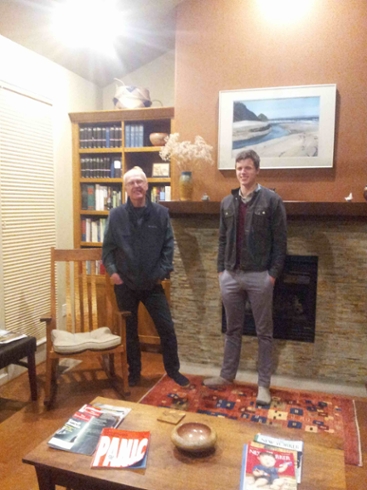
This past winter I had the opportunity to stay with two retired land use professionals, one a Reedie, and shadowed a number of employees at Bend’s Growth Management Department. Susan Brody, the Reedie, had formerly worked as the Director of Eugene’s Planning and Development Department, and as the Director of Oregon’s Department of Land Conservation and Development. Her husband, Al, is a retired land use attorney who had his own practice. Though they only moved to Bend two years ago, they are both active community members. As members of (different) Technical Advisory Committees, they each work closely with the Growth Management Department and project manager Brian Rankin to help expand Bend’s Urban Growth Boundary.
I applied to this externship because I was interested in a career that used technical skills and analytical thinking to develop impactful public policy. Discussions of Portland’s housing crisis and gentrification problems hinted that planning might be one such career. My experience in Bend unambiguously confirmed that hunch. The people I shadowed were dedicated to crafting the best Bend they (or more accurately, the public) could imagine, while working within the constraints of a municipal department.
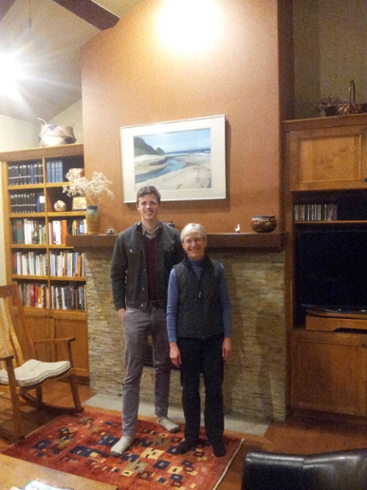
Continue reading Growth Management Department of Bend, Oregon: Philip Stallworth, Winter Shadow 2016
